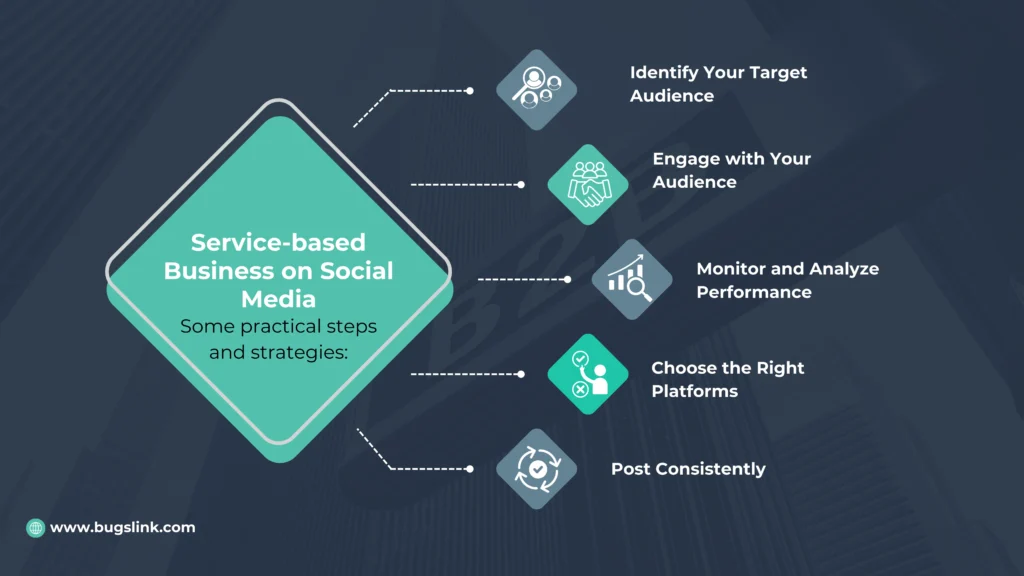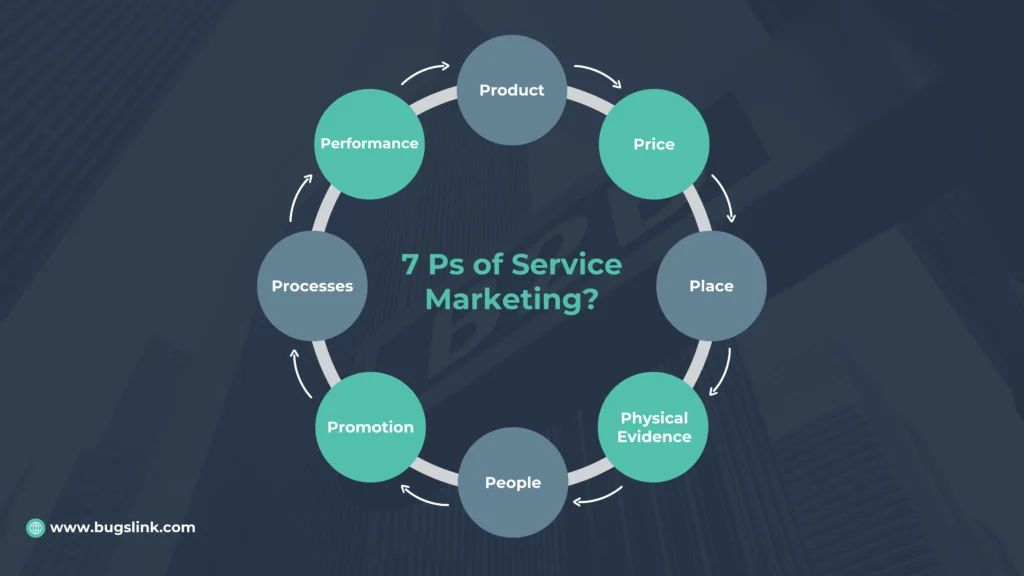Social media marketing is crucial for growing service-based businesses in the digital era. Platforms such as LinkedIn, Twitter, Instagram, and Facebook offer exceptional options for interacting with new clients and companies by producing brand awareness and promoting business growth. This blog will explore how to market a service-based business on social media by focusing on the 7 Ps of marketing.
How Do you Market a Service-Based Business on Social Media?

Social media marketing for a service-based company requires strategic planning and creative implementation. These techniques will enable you to develop a strong web presence and market your service-based company properly.
Here are some practical steps and strategies:
Identify Your Target Audience
- Determine your ideal customers.
- Look at their interests, internet behavior, and demographics.
Choose the Right Platforms
- Attentively choose the platform according to your audience interaction choices.
Content Creation
- Content creation is the next critical chain that connects you with your desired company. Produce what your audience strives for, including tips for business improvement, customer testimonials, and Q&A sessions.
Optimize Your Profiles
- Use a professional profile picture and cover image.
- Write a clear and compelling bio.
- Include relevant keywords for SEO.
Post Consistently
- To keep up a consistent posting schedule, create a content calendar.
- For scheduling, make use of applications like Hootsuite or Buffer.
Engage with Your Audience
- Answer messages and comments as soon as possible.
- Engage in appropriate discussions and forums.
- Express gratitude for content produced by users.
Leverage Visuals
- Make use of excellent photos and videos.
- Your postings will stand out if you use infographics and branded images.
Utilize Hashtags and Keywords
- Research and use relevant hashtags to increase reach. Use keywords that are your target audience.
Run Paid Ads
- Invest in ads to catch a wider audience. Ads are targeted based on geographic location, interests, and activity.
Collaborate with Influencers
- Partner with influencers in your industry to reach their followers.
- Consider micro-influencers for a more engaged audience.
Monitor and Analyze Performance
- Use analytics tools to track engagement, reach, and conversion.
- Adjust your strategy based on what works best.
Offer Promotions and Discounts
- Use limited offers and promote exclusive deals and discounts to show a sense of urgency.
What are the 7 Ps of Service Marketing?

Product
- The company’s services are named the “product. In contrast to actual products, services are immaterial and cannot be possessed. For client attraction, these services must be of high caliber and customized. By customizing services to match the demands of their clients, businesses can increase customer happiness and loyalty. It may include tailoring consultations to the individual, creating custom packages, or giving flexible service options.
Price
- Pricing is a critical component of the marketing. Service-oriented businesses must develop pricing strategies that consider the value of their products and services, their target market, and the degree of competition.
- Several variables affect pricing decisions, including perceived value, market demand, and service delivery costs. When setting prices, businesses must also consider their target market and positioning.
Place
- The channels used to supply services are called the “place” in service marketing. Online platforms are critical for a lot of service-based firms. Social media sites, business websites, and third-party service platforms are all included.
- Having a solid internet presence is crucial. It entails ensuring services are easily accessible to potential customers, updating social media profiles, and optimizing websites for search engines.
Promotion
- Promotion includes all the different ways services are communicated to prospective customers and their value. Examples of efficient advertising strategies are online, email, and content marketing.
- Social media campaigns are effective for service-oriented firms. Through influencer marketing, targeted advertising, and exciting content creation, businesses may reach a large audience and increase engagement.
People
- The face of enterprises that provide services is their workforce. Their demeanor, abilities, and interactions with customers directly affect client satisfaction. It is essential to invest in the training and development of employees.
- Establishing solid relationships requires having positive customer interactions. It entails attentive and timely communication, tailored support, and realistic resolution of client concerns.
- Procedure
Process
- The processes and methods used to supply services are called service delivery. Improving client happiness and efficiency can be achieved by streamlining these operations.
- Delivering dependable, superior service is essential to improving the client experience. It could involve getting client input, utilizing technologies to streamline service delivery, and consistently enhancing procedures.
Physical Evidence
- The tangible components of the service provided, such as the logo, setting, and internet presence, are physical evidence. With clients, it promotes credibility and trust.
- Customer testimonials, branded materials, and official websites are a few examples of tangible proof. Effectively implementing these components can improve the company’s reputation.
What is the Process of Service Marketing?
Marketing a service-based business effectively requires a structured approach that engages potential clients and builds long-term relationships. Here’s a comprehensive look at the service marketing process, using effective strategies to ensure your marketing efforts yield the best results.
Conduct Market Research
The first step in the service marketing process is to conduct thorough market research. This involves using various techniques, such as surveys and focus groups, to gather valuable insights about your target audience. Surveys can help you understand customer preferences, while focus groups provide a more in-depth view of what drives customer decisions. Ensure that your surveys are concise and engaging to encourage participation, and use open-ended questions to gather qualitative feedback.
Segment Your Audience
Once you have gathered data from your market research, the next step is to segment your audience. This involves dividing the broader audience into smaller, manageable groups based on specific characteristics such as demographics, behaviors, and preferences. Segmenting your audience allows you to tailor your marketing strategies and messages to resonate with each group effectively, ultimately leading to higher conversion rates. Using customer personas can help you visualize and better understand each segment, guiding your marketing efforts and ensuring your messaging is on point.
Set Clear Objectives and Create a Marketing Mix
With a segmented audience in mind, it’s crucial to set clear marketing objectives. Determine what you want to achieve with your service marketing efforts, whether it’s increasing brand awareness, generating leads, or boosting customer retention. Once your objectives are set, create a well-rounded marketing mix that includes the four Ps: Product, Price, Place, and Promotion. Each element should align with your goals and address the needs of your target audience.
Understand Your Audience Through Compelling Visuals and Narratives
An essential aspect of service marketing is to understand your audience deeply. Craft messages that resonate with their needs, desires, and pain points. Use compelling visuals and solid narratives to tell your brand’s story. Utilize eye-catching graphics, infographics, and videos to make your content more engaging, especially on platforms like Instagram and Facebook. Sharing success stories, testimonials, and case studies that highlight the positive impact of your services builds trust and demonstrates your expertise.
Choose the Right Platforms
Selecting the appropriate social media platforms is crucial based on your target audience and the nature of your service. Research where your audience is most active and tailor your content accordingly. LinkedIn is ideal for B2B services, connecting professionals and decision-makers, while Facebook and Instagram are great for engaging a broader audience with visual content. Analyzing your competitors can provide insights into which platforms to focus on for your marketing efforts.
Execute, Monitor, Adjust, and Measure Strategies
Finally, it’s time to execute your marketing plan. However, the process doesn’t end there. It’s crucial to continuously monitor, adjust, and measure your strategies using Key Performance Indicators (KPIs) to ensure they are effective. Implement your marketing initiatives as planned, keeping your audience engaged with regular posts and interactions. Use analytics tools to track engagement, reach, and conversion rates, and be flexible and willing to pivot your strategies based on real-time feedback and performance data. Regularly review your KPIs to evaluate the success of your campaigns and make data-driven decisions for future efforts.
Challenges and Solutions Marketing
Businesses that provide services face unique hurdles regarding social media marketing. Common problems include keeping current, handling unfavorable comments, and calculating return on investment. Some solutions include using analytics tools, maintaining a significant internet presence, and keeping up with trends.
Conclusion
To effectively market a service-based business on social media, follow the 7 Ps of service marketing, create engaging content, choose suitable platforms, and measure success. Your business can build a strong presence and drive growth by understanding your audience, selecting the right platforms, and consistently measuring performance.
FAQs
Social media marketing services raise brand exposure, target specific demographics, and provide expertise in producing engaging content and performance analysis to enhance results.
How often you post depends on your audience and the site. Post three to four times weekly to stay current and keep your audience interested.
Social media increases product visibility and customer involvement by reaching a large audience with relevant ads and interesting content.
For B2B marketing, LinkedIn is ideal for sharing industry insights, company news, and case studies to build credibility. Engaging with other businesses through comments and discussions fosters valuable connections in your industry.

